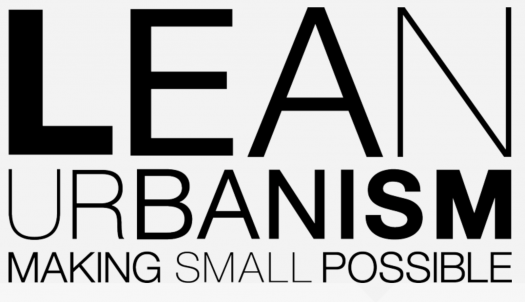A Placemaking Journal
From Ideas to Action: Cheaply, quickly, fairly
Last week, in the Congress for the New Urbanism’s “Public Square” blog, sociologist David Brain outlined strategies for a Lean charrette, which is a work-in-progress concept designed to match up with Lean Urbanism strategies. Opportunist that I am, I welcome that as an excuse to try Part 2 of the charrette discussion I offered here.
Also, there’s this: PlaceMakers is a volunteer coordinator for a National Charrette Institute training in Asheville, May 16-20. David Brain will be there, along with NCI executive director Bill Lennertz. There will be lots of discussion about these ideas during that week, and we’d love to see as many folks as possible get in on the conversation. Plus, Asheville is a pretty swell place to hang out in May.
If you’re not familiar with the Lean Urbanism talk, you can get the full download here. But behind the concepts is a recognition of reality: As much as we’d like to reverse all at once everything stupid we did over the last half-century in the ways we’ve done land and infrastructure planning, there appears to be a reluctance in most places to dedicate the megabucks and endure the time and energy-sapping political battles required for big fixes. So why not focus on making big differences in smaller, faster, more incremental ways?

Brain’s blog post did a good job of explaining how to use a leaner charrette process to do that without tossing out what makes a charrette so effective at getting from visioning to idea-sorting to implementation. Here’s my paraphrasing of three of Brain’s keepers:
- Commit to comprehensiveness. That means an inclusive, multidisciplinary approach that allows for a wide range of inputs and critiques, both from technical experts and from those who just know the turf from living and working there.
- Leverage the advantages of a compressed time frame. Make it clear the goal is to have the framework of an actionable plan, and organize sessions and tasks to systematically sort through ideas, establish priorities and shape consensus-driven strategies by the end of the charrette.
- Invite trust through transparency. Everybody gets to review and critique both the rules for idea-sorting and the evolution of emerging strategies. It’s always easier to get buy-in for products that were co-created by customers.
Getting all that into a smaller budget, smaller team process that still delivers something actionable in the short term requires a division of labor that’s almost never part of the deal planning consultants currently make with their clients. Brain is too polite to put it exactly that way, but he acknowledges the challenge:
To move efficiently, however, requires a certain amount of pre-established agreement with respect to values, goals, and some important limits to be respected. For example, a previous set of discussions and workshops might have established and branded a Lean project, linking it to a diverse set of interest and allies. Whatever the specific project might be at hand, it can be conceived as a manifestation of that initiative and thereby benefit from what is hopefully a diverse collection of allies.
So here comes the hard part:
If budgets and teams are slimmed down and we still want to get where tried-and-true charrette techniques help us go, then somebody has to take up the slack in assuring there’s “a certain amount of pre-established agreement with respect to values, goals, and some important limits to be respected.” So far, many municipal and regional governments have nailed the smaller-budget component of Lean. Most of the RFPs I’ve seen, however, invite assumptions that nothing like that kind of agreement is in place; so getting to that point is often part of the required scope and in consultants’ responses, often wedged into a reduced-price charrette.
What’s most helpful about the new Lean Charrette idea is the idea of re-assigning the costly and time-consuming visioning component of a charrette to an entirely separate stage of pre-charrette public engagement. The most logical responsible party for that task: The client. After all, shouldn’t the establishment and maintenance of a trusting environment for talking about the future be fundamental to a government’s function?
Okay, that’s way too out there. Let’s look at it another way. Lots of places, especially in this time of political polarization, find themselves severely disadvantaged when it comes to making the most basic plans for land use, transportation, zoning and infrastructure. So what they need is to embrace the Lean idea — small steps towards bigger ideas, starting with the crucial step of reestablishing trust that governments can get stuff done that most people agree are improvements to their quality of life.
Consultants are equipped to help with that trust building if governments can’t manage it in-house. But it shouldn’t be a one-off effort attached to one project or plan. The goal should be to establish that agreement about values and rules for planning in ways that make it renewable, a foundation for vision continuity enabling future planning efforts to be more focused and fast moving — and less expensive.
–Ben Brown
If PlaceShakers is our soapbox, our Facebook page is where we step down, grab a drink and enjoy a little conversation. Looking for a heads-up on the latest community-building news and perspective from around the web? Click through and “Like” us and we’ll keep you in the loop.






